Apep (WR 70-16) is a triple star system located approximately 15,000 light-years away in the faint southern constellation of Norma (the Level). The massive star system is the first gamma-ray burst progenitor candidate discovered in the Milky Way. With an apparent magnitude of 17.5, it is invisible to the unaided eye and cannot be seen in small and medium telescopes. The star system is surrounded by a large pinwheel nebula. The Apep nebula was imaged by the James Webb Space Telescope (JWST) in 2025.
Star system
Apep is a star system composed of a Wolf-Rayet binary star and a hot blue O-type supergiant. The system is surrounded by a large complex of nebulosity formed by cosmic dust and stellar wind from the massive central binary system. The Wolf-Rayet stars have masses 10 to 15 times that of the Sun and a luminosity of more than 100,000 Suns.
The pinwheel shape of the Apep nebula is the result of the primary component’s high rotation speed and the influence of the secondary component as the pair orbits each other with a period of around 193 years. The spectacular dust plume centered on the Wolf-Rayet binary appears 12 arcseconds across in the mid-infrared band.
The Apep star system has a combined apparent magnitude of 17.5. The Wolf-Rayet binary star – the central engine – shines at magnitude 19.0 and the northern companion has a magnitude of 17.8. In the infrared J band, the components have apparent magnitudes of 10.2 ± 0.2 and 9.6 ± 0.2.
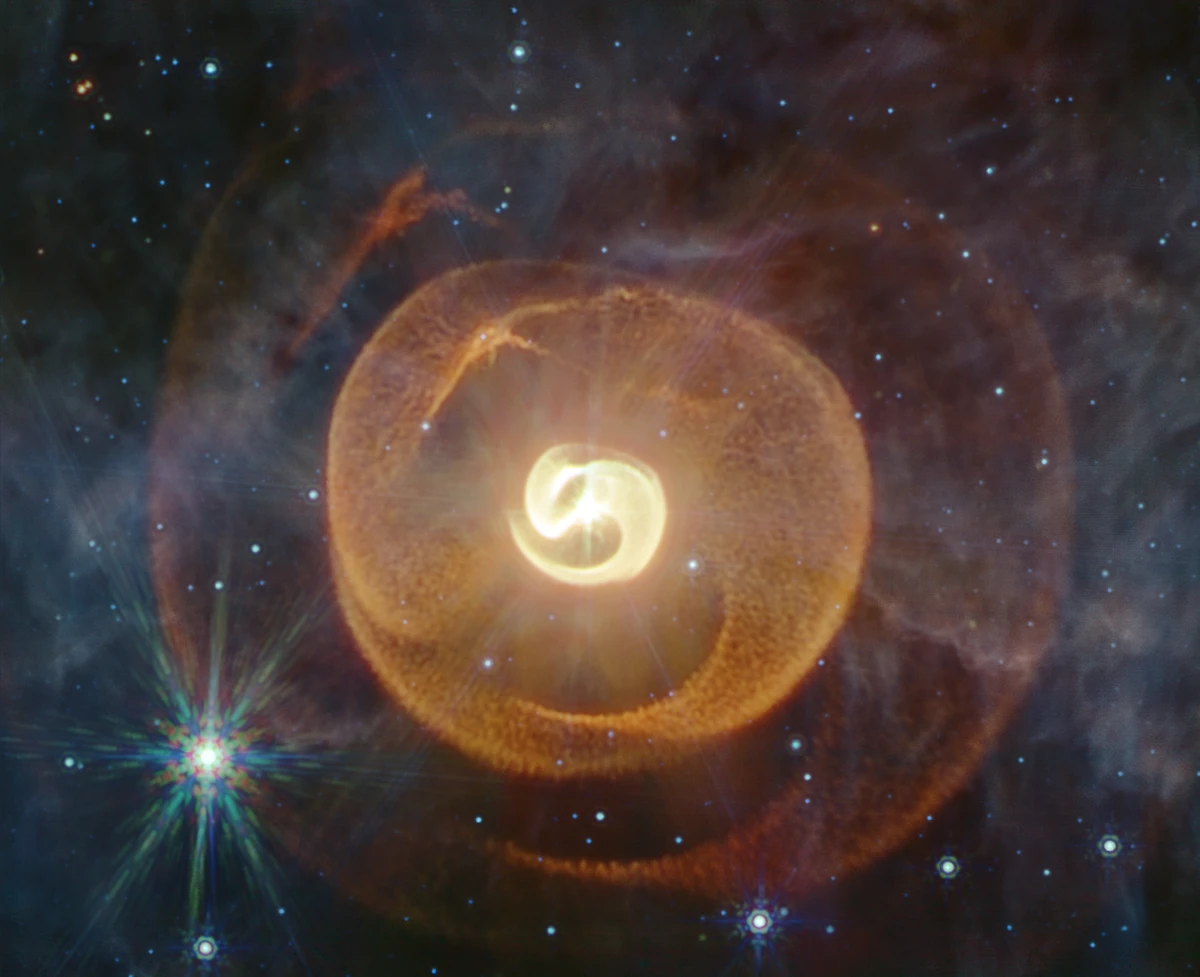
Apep star system and nebula captured by the James Webb Space Telescope (JWST), image credit: Judy Schmidt, Yinuo Han et al. (CC BY 4.0)
The colliding wind binary (CWB) at the centre of the system consists of a pair of classical Wolf-Rayet stars with the carbon- and nitrogen-sequence spectral types WC8 and WN4-6b. The carbon-sequence star is primarily responsible for the production of dust in the system.
The system resembles WR 104 (the Pinwheel Star) in the constellation Sagittarius, another well-known triple star system with a WC-type primary component surrounded by a spiral Wolf-Rayet nebula. The Wolf-Rayet star WR 98a in Scorpius has a similar pinwheel dust pattern.
Wolf-Rayet stars are exceptionally rare. As of August 2025, only around 700 of these stars have been identified. WR stars have prominent emission lines of ionized helium as well as ionized nitrogen or carbon, and a very low abundance of hydrogen. They are among the hottest stars known.
Few stars are massive enough to evolve into WR stars after a period as red supergiants or blue supergiants. They do not go out as supernovae in the supergiant phase but instead become hotter. By this point, they have burned through almost all their hydrogen and are fusing helium in their cores. At the very end, they fuse heavier elements before ending their lives as luminous supernovae.
The copious amounts of dust in the Apep nebula are produced from the shock of the colliding stellar winds from the two stars. The outflowing dust plume is turned into a spiral nebula by the stars’ orbital motion. The wind is moving at a velocity of 12 million km/h, and the dust is travelling at 2 million km/h. The high velocity of the stellar wind indicates that at least one of the Wolf-Rayet components is a very fast spinner. The interaction of the faster stellar winds at the star’s poles and the slower winds at the equatorial region, combined with the interaction of the stellar wind from the secondary component, is responsible for creating the nebula’s pinwheel shape. The collision of the winds from the carbon-type Wolf-Rayet star and the massive supergiant companion creates a thick, carbon-rich environment conducive to dust production.
Composed of three massive supernova candidates, the Apep system is the best-known gamma-ray burst progenitor candidate in our galaxy. Fast-spinning Wolf-Rayet stars are believed to be potential gamma-ray progenitors when they go out as supernovae. Apep was the first gamma-ray progenitor discovered in the Milky Way galaxy. These systems were previously believed to only exist in galaxies younger than our own.
The third component in the system is a hot supergiant star of the spectral type OIaf. It orbits the central Wolf-Rayet binary with a period of at least 10,000 years at an orbital distance of around 1,700 astronomical units (AU). It appears at a separation of 0.7 arcseconds from the main pair.
The distance of 15,000 light-years (4.6 kiloparsecs) was determined by a team of astronomers led by Yinuo Han, Division of Geological and Planetary Sciences, California Institute of Technology (Caltech), California in a study published in 2025. The study was based on observations with the MIRI Imager aboard the James Webb Space Telescope (JWST) and the VISIR camera on the Very Large Telescope’s UT2 telescope at Paranal Observatory in the Atacama Desert of northern Chile. At the system’s estimated visual extinction of 11.4, there is a potential discrepancy between 9,132 and 16,634 light-years (2.8 and 5.1 kpc).
The distance of 15,000 light-years implies a combined luminosity of 1.6 million solar luminosities for the binary star system WR 70-16 and 1.1 solar luminosities for the O star companion.
The Webb observations revealed four nested concentric dust shells with highly regular structures in the Apep nebula, as well as a diffuse filamentary nebula. The dust shells have a mean expansion velocity of 90 milliarcseconds yr-1. The mean spacing between the shells of 17.30 arcseconds. The astronomers derived an orbital period of 193 years for the binary pair. They proposed that the dust structure observed formed within the past 700 years.
The third star is known to be physically bound to the WR binary system. A 2025 study led by Ryan M. T. White of the School of Mathematical and Physical Sciences, Macquarie University, Sydney, Australia, demonstrated that the blue supergiant star carves a cavity in the complex spiral dust nebula around Apep. The team confirmed an orbital period of at least 190 years for the Wolf-Rayet binary.
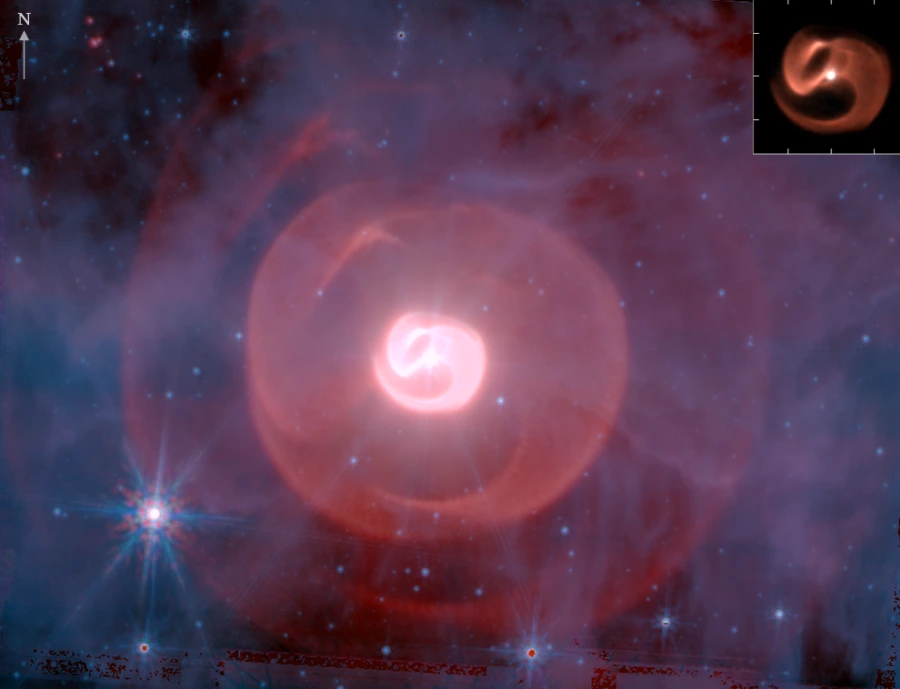
Colour image of Apep created from JWST/MIRI observations with the F770W, F1500W and F2550W filters. North is oriented towards the top of the page. A colour image of the inner dust shell observed with VLT/VISIR in the 2024 epoch is shown in the inset. Image credit: Han et al. (CC BY 4.0)
Facts
The Apep star system was discovered by astronomer Joseph R. Callingham while completing his undergraduate studies at the University of Sydney. The discovery of the potential gamma-ray burst progenitor in the Milky Way was announced in the scientific journal Nature Astronomy in 2018.
Callingham observed the system with the Molonlgo Observatory Synthesis Telescope (MOST), a radio telescope operated by the School of Physics of the University of Sydney. The system was previously identified as an X-ray source after observations with the XMM-Newton space observatory and the Chandra X-ray Observatory in August 2004. It appears bright at X-ray, infrared and radio wavelengths. It shows significant variation in radio emission, but the X-ray emission is relatively static.
Australian astronomer Peter Tuthill, who had previously discovered the dusty pinwheel nebula around WR 104, led the observations of Apep with European Southern Observatory’s Very Large Telescope (VLT) in 2016. The VLT images confirmed that the system was a colliding-wind binary and not a young stellar object.
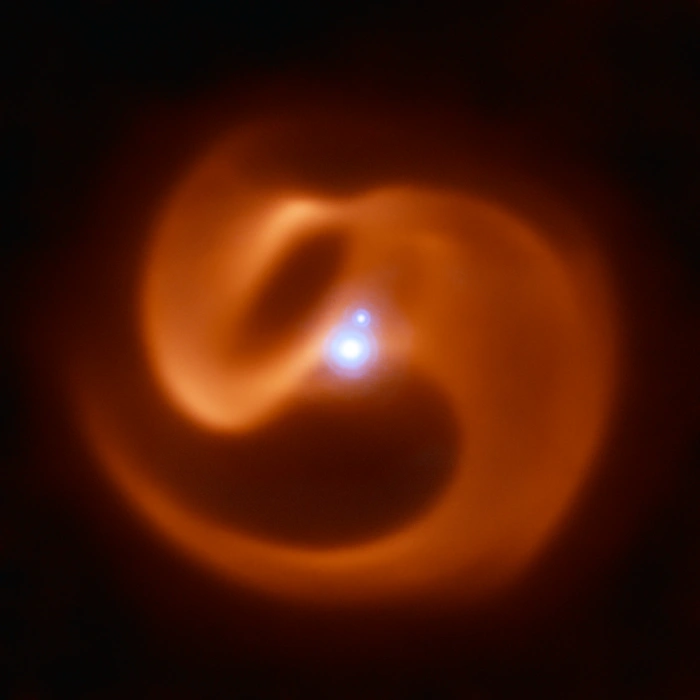
The VISIR instrument on ESO’s VLT captured this stunning image of a newly-discovered massive binary star system. Nicknamed Apep after an ancient Egyptian deity, it could be the first gamma-ray burst progenitor to be found in our galaxy. Apep’s stellar winds have created the dust cloud surrounding the system, which consists of a binary star with a fainter companion. With 2 Wolf-Rayet stars orbiting each other in the binary, the serpentine swirls surrounding Apep are formed by the collision of two sets of powerful stellar winds, which create the spectacular dust plumes seen in the image. The reddish pinwheel in this image is data from the VISIR instrument on ESO’s Very Large Telescope (VLT), and shows the spectacular plumes of dust surrounding Apep. The blue sources at the centre of the image are a triple star system — which consists of a binary star system and a companion single star bound together by gravity. Though only two star-like objects are visible in the image, the lower source is in fact an unresolved binary Wolf-Rayet star. The triple star system was captured by the NACO adaptive optics instrument on the VLT. Image credit: ESO/Callingham et al. (CC BY 4.0)
Subsequent infrared imaging of Apep revealed a new puzzle for astronomers. Even though the gas in the system had a velocity of more than 3,400 km/s, the dust pattern appeared to be hardly moving.
A 2020 study led by J. R. Callingham measured terminal line-of-sight velocities of 2,100 ± 200 and 3,500 ± 100 km s−1 for the WC8 and WN4-6b stars. The astronomers proposed that, since the dust plume had a significantly smaller expansion velocity, one of the Wolf-Rayet components may have an anisotropic wind (a wind with different velocities when measured in different directions). The team proposed a model in which the WC8 star is rotating at near-critical speed and produces a much slower equatorial wind with a velocity of around 530 km s-1.
Name
The name Apep (pronunciation: /ˈɑːpɛp/) comes from Egyptian mythology. The star system was named after Apep (Apophis or Aphoph), the ancient Egyptian god of chaos and the underworld and opponent of the solar deity Ra. The mythical Apep was depicted as a giant serpent or snake.
The star system was named Apep by a team of astronomers led by Joseph Callingham of the Netherlands Institute for Radio Astronomy (ASTRON). Callingham and his team observed the system from 2016 to 2018 and proposed the name Apep because of the “sinuous form of this infrared plume.” The astronomers found that images of the system evoked a “star embattled within a dragon’s coils.”
Apep has the Wolf-Rayet star designation WR 70-16 and is catalogued as 2XMM J160050.7−514245 in the XMM-Newton Serendipitous Source Catalogue (2XMM).
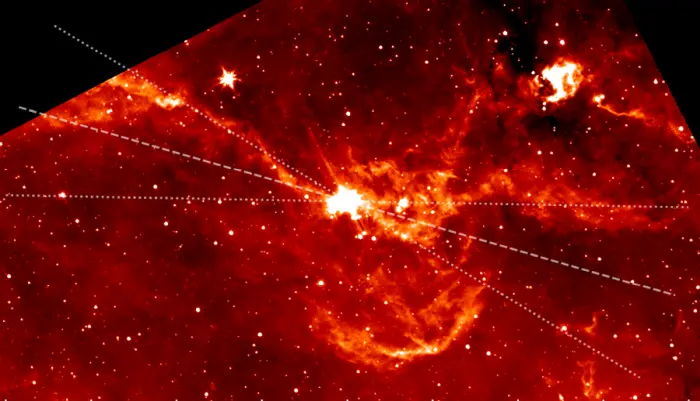
Apep by the Spitzer Space Telescope, credit: NASA/JPL-Caltech (PD)
Location
Apep appears in the constellation of Norma, which lies between the brighter Scorpius, Lupus and Triangulum Australe. The star system is located roughly halfway between Epsilon Centauri in Centaurus and Sargas in Scorpius.
At declination −51° 43′, the region of the sky around Apep never rises for observers north of the latitude 38° N. The Apep star system cannot be observed in backyard telescopes.
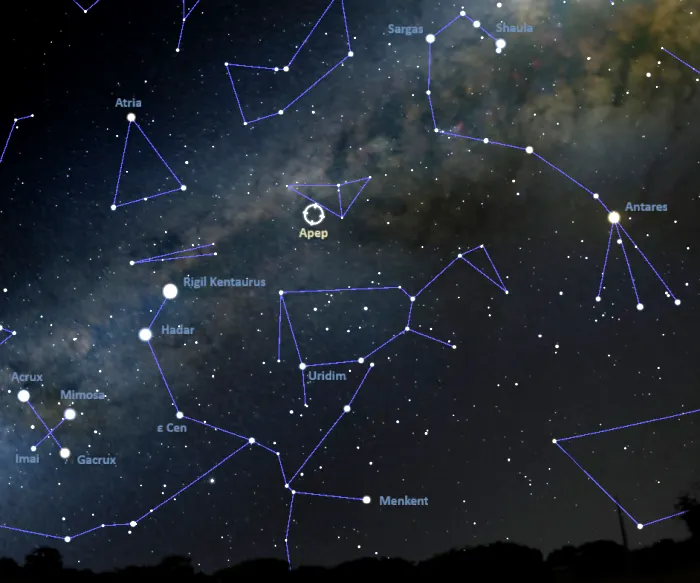
Apep location, image: Stellarium
Constellation
Apep is located in the constellation Norma. Representing the Level, Norma is one of the faintest and smallest constellations in the sky. Stretching across 165 square degrees, it is the 74th largest of the 88 modern constellations. It does not contain any stars brighter than magnitude 4.0.
Norma is one of the southern constellations created by the French astronomer Nicolas-Louis de Lacaille in 1751-1752. Lacaille observed the southern sky from the Cape of Good Hope in South Africa and introduced 14 constellations that are not visible from Europe. He named most of them after instruments associated with the Age of Enlightenment.
The brightest star in Norma is Gamma2 Normae, a yellow giant that shines at magnitude 4.02 from a distance of 138.4 light-years. Other notable stars in the constellation include the hot blue triple star system Epsilon Normae, the quadruple system Iota1 Normae, the yellow giants Eta Normae and Kappa Normae, the astrometric binary star Delta Normae, the luminous blue supergiant Mu Normae, the yellow-white supergiant Gamma1 Normae, the Cepheid variable V378 Normae, the Mira variable T Normae, the variable B-type supergiant QU Normae, and the yellow supergiant S Normae, the brightest member of the S Normae Cluster (NGC 6087).
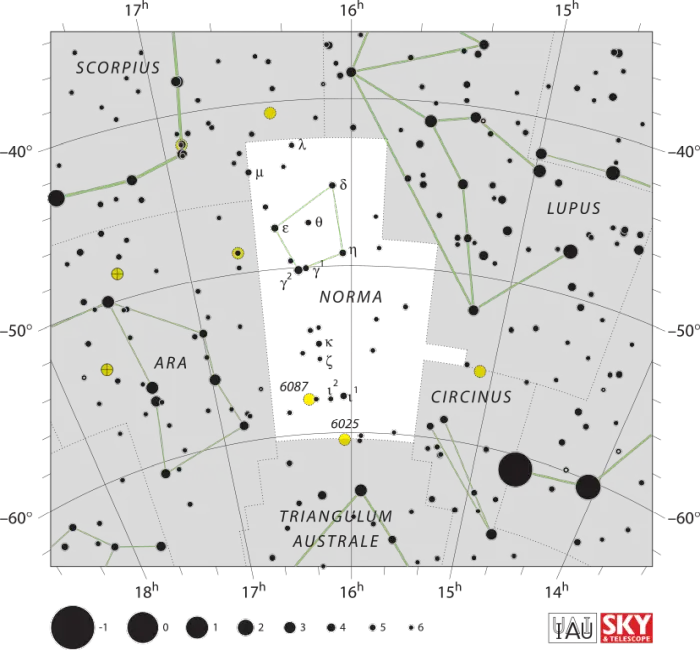
Norma constellation map by IAU and Sky&Telescope magazine (Roger Sinnott & Rick Fienberg) (CC BY 3.0)
Other deep sky objects in Norma include the open clusters NGC 6067, NGC 6134, NGC 6167, NGC 6031 and NGC 5999, the planetary nebulae Shapley 1 (the Fine Ring Nebula), Mz 1 and Mz 3 (the Ant Nebula), and the Norma Cluster of galaxies (Abell 3627).
The best time of the year to observe the stars and deep sky objects in Norma is during the month of June, when the constellation appears higher above the horizon in the early evening. The entire constellation is visible from locations south of the latitude 30° N.
The 10 brightest stars in Norma are Gamma2 Normae (mag. 4.02), Epsilon Normae (mag. 4.47), Iota1 Normae (mag. 4.63), Eta Normae (mag. 4.65), Delta Normae (mag. 4.74), Mu Normae (mag. 4.91), Kappa Normae (mag. 4.94), Gamma1 Normae (mag. 4.98), Theta Normae (mag. 5.13), and HD 147152 (mag. 5.32).
Apep – WR 70-16
| Spectral class | WC8 + WN4-6b + OIaf |
| Apparent magnitude (V) | 17.5 |
| Apparent magnitude (J) | 10.2 |
| Apparent magnitude (K) | 6.9 |
| Absolute magnitude | -5.15 / -5.15 / -7.4 |
| Distance | 15,000 light-years (9,132 – 16,634 ly); 4,600 parsecs (2,800 – 5,100 parsecs) |
| Constellation | Norma |
| Right ascension | 16h 00m 50.47872s |
| Declination | −51° 42′ 44.9784″ |
| Names and designations | Apep, WR 70-16, 2MASS J16005047-5142449, AX J1600.9-5142, 1RXS J160045.0-514307, SRGA J160050.0-514249, TIC 274741039, WISE J160050.53-514245.2, WISEA J160050.46-514245.5, 2XMM J160050.7-514245 |